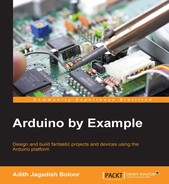Book Description
Design and build fantastic projects and devices using the Arduino platform
About This Book
- Explore the different sensors that can be used to improve the functionality of the Arduino projects
- Program networking modules in conjunction with Arduino to make smarter and more communicable devices
- A practical guide that shows you how to utilize Arduino to create practical, useful projects
Who This Book Is For
This book is an ideal choice for hobbyists or professionals who want to create quick and easy projects with Arduino. As a prerequisite, readers must have a working Arduino system and some programming background, ideally in C/C++. Basic knowledge of Arduino is helpful but not required to follow along with this book.
What You Will Learn
- Understand and utilize the capabilities of the Arduino
- Integrate sensors to gather environmental data and display this information in meaningful ways
- Add modules such as Bluetooth and Wi-Fi that allow the Arduino to communicate and send data between devices
- Create simple servers to allow communication to occur
- Build automated projects including robots while learning complex algorithms to mimic biological locomotion
- Implement error handling to make programs easier to debug and look more professional
- Integrate powerful programming tools and software such as Python and Processing to broaden the scope of what the Arduino can achieve
- Practice and learn basic programming etiquette
In Detail
Arduino an opensource physical computing platform based on a simple microcontroller board, and a development environment for writing software for the board. The opensource Arduino software (IDE) makes it easy to write code and upload it to the board. It runs on Windows, Mac OS X, and Linux. The environment is written in Java and based on Processing and other opensource software.
With the growing interest in home-made, weekend projects among students and hobbyists alike, Arduino offers an innovative and feasible platform to create projects that promote creativity and technological tinkering.
Arduino by Example is a project-oriented guide to help you fully utilize the power of one of the world's most powerful open source platforms, Arduino. This book demonstrates three projects ranging from a home automation project involving your lighting system to a simple robotic project to a touch sensor project. You will first learn the basic concepts such as how to get started with the Arduino, and as you start building the project, you will develop the practical skills needed to successfully build Arduino powered projects that have real-life implications.
The complexity of the book slowly increases as you complete a project and move on to the next. By the end of this book, you will be able to create basic projects and utilize the elements used in the examples to construct your own devices.
Style and approach
This book follows a project-oriented approach, with multiple images and plenty of code to help you build your projects easily. The book uses a tutorial-based methodology where the concepts are first explained and then implemented to help you develop the projects.
Downloading the example code for this book. You can download the example code files for all Packt books you have purchased from your account at http://www.PacktPub.com. If you purchased this book elsewhere, you can visit http://www.PacktPub.com/support and register to have the code file.
Table of Contents
- Arduino by Example
- Table of Contents
- Arduino by Example
- Credits
- About the Author
- Acknowledgements
- About the Reviewers
- www.PacktPub.com
- Preface
- 1. Getting Started with Arduino
- 2. Digital Ruler
- 3. Converting Finger Gestures to Text
- 4. Burglar Alarm – Part 1
- 5. Burglar Alarm – Part 2
- 6. Home Automation – Part 1
- 7. Home Automation – Part 2
- 8. Robot Dog – Part 1
- 9. Robot Dog – Part 2
- 10. Robot Dog – Part 3
- Index
